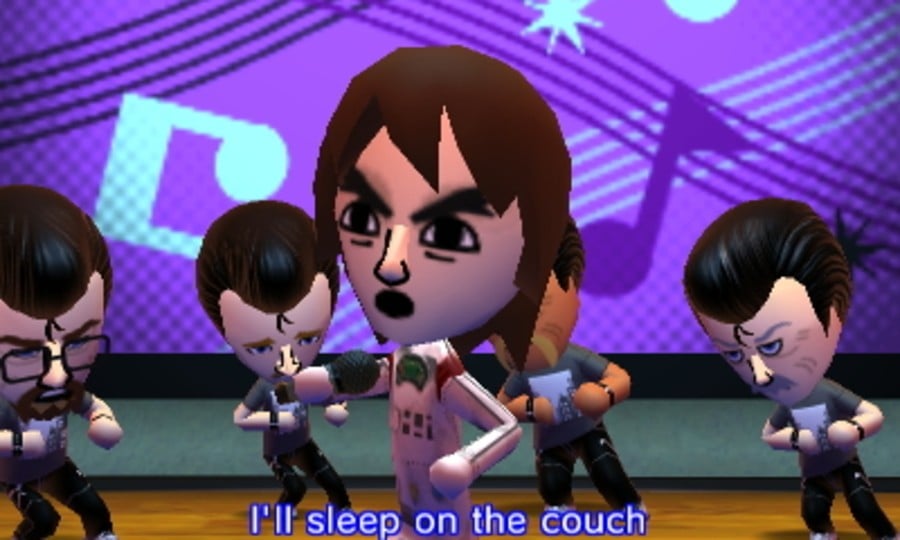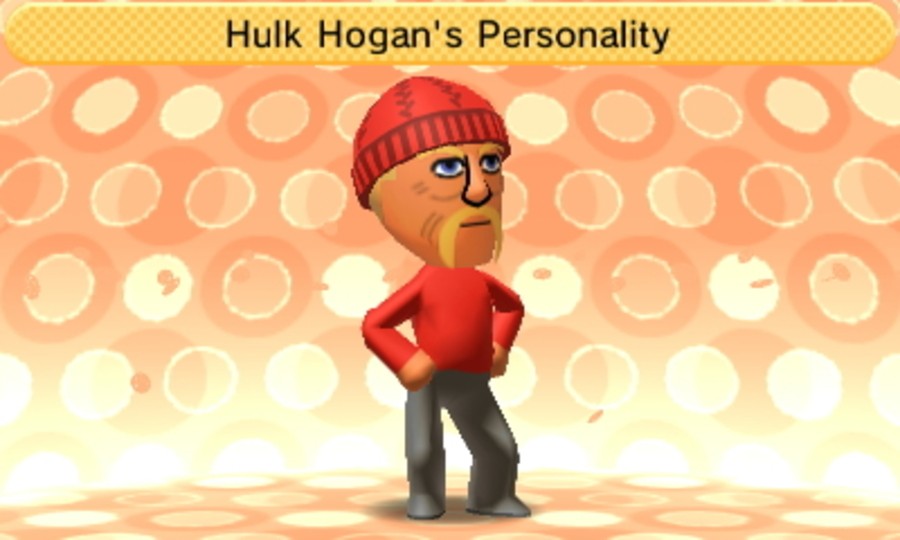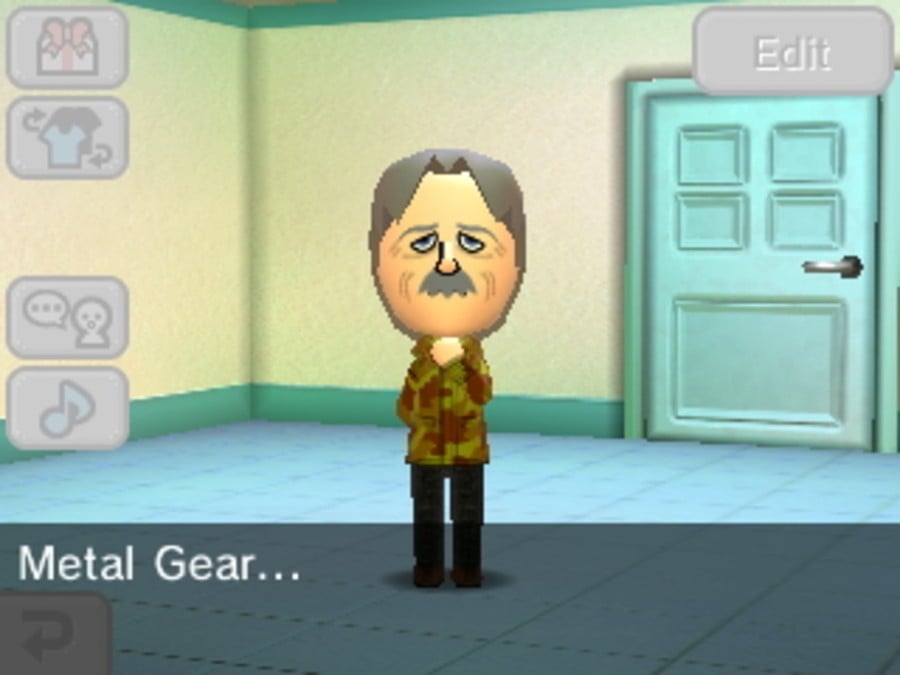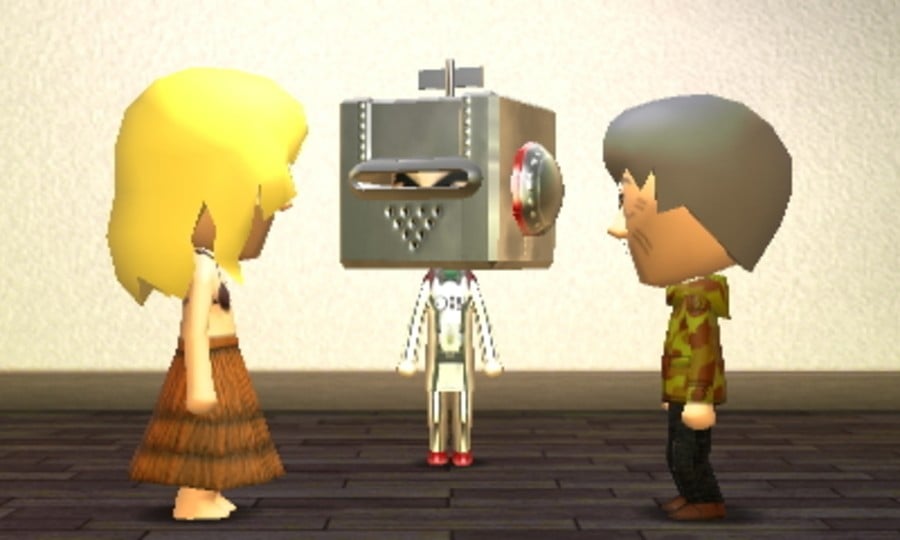
To me, the allure of Tomodachi Life had always been somewhat mysterious. After the bizarre promo reel shown on Nintendo Direct the title had piqued my interest, but I was hesitant to get on board due to how downright unique the game appeared to be. How could I be sure I’d enjoy a game that is beyond genre classification? What if the entire game was just a series of weird skits with no underlying premise? It was these thoughts that left me pondering the purchase for a number of weeks.
I now know that I was wrong to hesitate. Tomodachi Life is many things; confusing, hilarious, charming and unique – but it’s never boring.
Tomodachi Life starts simply enough, with the player either constructing or importing a Mii of themselves into the game to inhabit an island (with a name of their choice – I opted for Kuribo). The customisation options here are impressive – whilst the Miis are regrettably limited to the palette of features found in the standard Mii maker, options such as the Mii’s tone and pitch of voice, accent, and even pronunciation of their names can all be modified for a closer likeness. The undisputed highlight of the customisation process, though, is the personality calculator; using sliders to adjust a Mii’s demeanor and mannerisms, Tomodachi Life spits out a brief synopsis of your clone's personality. Provided you are honest when positioning your sliders these are surprisingly close, and my Mii was assigned an accurate (if not slightly unflattering) personality. These personalities are more than just window-dressing, though, and my Mii would constantly spout pessimistic and chillingly familiar statements whenever I paid them a visit.

After moving into his sparsely decorated apartment, my diminutive doppelganger commented that I looked like him (which was rather the point) and insisted on referring to me as his ‘lookalike’. Each Mii has problems to be addressed by the player, such as hunger or wishing to visit a specific neighbour, and assisting in these dilemmas net both ‘experience’ for the Mii and currency for the player. Finding out the Mii’s likes and dislikes are key to advancing in the game and is an oddly charming process – discovering that Hulk Hogan is a huge tea drinker, for instance – whilst the currency can be spent on further increasing your occupants’ happiness with further gifts and food. Each Mii has their own likes and dislikes, and discerning whether Jack Nicholson will enjoy the panda suit you have for him or whether it’s best saved for Iwata is the type of odd choice I found myself frequently presented with, and playing to each character’s established personality to maximise experience is entertaining and engaging.
Speaking of experience, Miis each have levels of happiness that can be reached by solving their problems, and upon levelling up Miis can receive a number of gifts. Items such as guitars and laptop can be bestowed on the characters, as can replacement room motifs, but the most entertaining gift is teaching a Mii a song. Songs can be performed at the town stage (complete with backing dancers) and are completely editable. Less than an hour into the game I had seen my Mii sing a rock ‘n’ roll jam entitled ‘That Smell’, wailing a swinging ballad about flatulence accompanied by Solid Snake and other associates in classic 50’s greaser garb. It’s surreal, but feels oddly natural – rather than being a series of random events, Tomodachi Life is more like a world where the extraordinary becomes commonplace, and whilst there’s a tongue-in-cheek theme that the player is the only sane person on this wild ride, it’s a cohesive world that Nintendo has built. My fears of Tomodachi Life being a string of non-sequiturs were quickly assuaged, and I find myself becoming strangely accustomed to the unique lifestyle of Kuribo Island.

Beyond the apartment building and the aforementioned musical stage there’s a wealth of landmarks to visit, each unlocked by fulfilling specified criteria. Upon moving in a certain number of Miis and solving a small number of their problems I unlocked the beach – Solid Snake was quick to visit the area with the metal detector I had presented him with upon levelling up, whilst Breaking Bad star Jesse Pinkman spent his spare time working in the local food shop. There’s never a shortage of odd exchanges and amusing events to witness, particularly as more residents are moved in, and their varying schedules ensure there’s always something for the player to engage in. Even sleeping Miis hold an entertainment value, as the player is able to enter their dreams and witness their bizarre hallucinations or, more maliciously, draw on their faces as they sleep.
In a nutshell, Tomodachi Life is a game about experiences. It’s about filling an enclosed space with an eclectic cast of residents and watching the insanity unfold. Tomodachi Life makes the extraordinary seem mundane in the best possible way, crafting a world where anything can (and often does) happen, but it happens for a reason based on situations and character personalities. It’s not about random humour that has no context, and it’s not about cheap laughs. It’s a genuinely entertaining, surprising experience that is constantly engaging and delightful.

For those on the fence, I wholeheartedly recommend taking the plunge and picking up Tomodachi Life. The admittedly brief Welcome Version can give the curious player a taste of the experience, but it’s only in the full product that the scope of the game becomes apparent. My short time on Kuribo Island has left me hungry for more; I want to see if Hulk Hogan and Solid Snake can settle their differences and become friends, I want to see if my digital counterpart can find love whilst dressed as a cheap cardboard robot, and I want to see how far the rabbit hole that is Tomodachi Life really goes.
Are you on the fence about Tomodachi Life? Has Rob's tale convinced you to take the plunge? Have you previously tried the game but came away unimpressed? Give us your feedback by posting something below.





Comments 33
Ummmmmm is Nintendo paying you guys to push this game this hard? Exclusive future info on games before everyone else perhaps? It really is repetitive, overpriced, and way overrated.
@Zach777
I'm just not feeling this game at all.
Most of it comes down the presentation and the way it all looks a bit haphazard and ultimately pointless; like obsessing over Farmville for months on end before coming to the realization you just wasted countless hours clicking squares to basically increase stats with no end purpose or gain at all (which thankfully I never fell for, although I did try it just to see what I was "missing").
Hey, it might be a brilliant game and I'm just being unfairly harsh and judgmental but I'm simply not feeling it at all.
I've seen a couple of videos that made me chuckle a little bit, not because it looks great but just because it was a bit daft and silly, and that's about it.
Maybe you just had/have to be there, as they say (although that's not really the correct way to use the phrase).
Tomadachi Life sure does get a lot of coverage... Kinda overkill at this point as I really don't see Tomodachi Life anywhere else but on Nintendo Life.. You guys must really like this game
Sick Kubrick reference, bro.
@Zach777
Kotaku and other sites are also sharing their experiences on this game. I don't think they are being paid by Nintendo. It's just that there are interesting or hilarious moments worth "sharing". Plus the game just came out so why not take advantage of it.
You do also realize that NLife makes a living on writing Nintendo-related articles? I mean look at Kotaku, IGN and other sites. They even make 5-10 articles in a single game. If you're not interested, don't read it. I skip most 3DS articles myself as I don't have one (although I click and have a quick scan on the content before closing it). It's better to have something to read on than nothing.
I wish i could do do that in the Mario Kart games.
Sorry, still on the fence. I hate these time suckers. My New Leaf is still in its wrap, because I fear the day I open it it will enslave me as Tom Nook does to your Villager.
And the fact that Rusty is the only Mii heavy game that I like does not help matters either.
Got Tomodachi at launch, but I admit I bought it with a voice in my head that was whispering "you gonna regret this OoO".
So glad I didn't listen to that voice, Tomodachi is one weird unique experience that I would reccomand to anyone ^o^
It's so hard to explain, but there is really a charm in seeing Miis taking life, sometimes acting in funny unexpected ways, sometimes acting exactly the same as the people they are based on (which is actually creepy how the game somehow know things I had no way to input into it >.>;;; ).
Good to see NintendoLife is still talking of this game, it really deserve some pushes forward
@Kirk Yeah, Aussie TV show 'Good Game' sums up perfectly why I don't really give a poop about it
I would like to have this, but I think I may hold out until a discount at least... I reeeeeeally don't want to pay $40 for it, but my interest is piqued. I just have so much else to play right now, ugh...
It's all about the photo opportunities within the game. Hit X, Y you instantly get that photo with all your friends in, funny quotes etc straight into Facebook it goes lol 😁
Once you play Tomodachi you'll understand why we talk about it.
The first wedding in my Tomodachi Life occurred when Benedict Cumberbatch proposed and married Dana Scully (X FIles). Such fun.
Man, I love this game. It's a really good time-waster. I've pumped a good few hours into it now. I think it's their reactions/expressions that make me laugh so hard. Amazing.
@DestinyMan you can you change the pronunciation of the names by using the little audio icon. Just spell the name normally, then click that icon and spell it how you want it to be pronounced. Works great for me.
In the demo, I called my island 'Konoha'.
While many of you may still be on the fence let me just say that this a fantastic game! Game of the Year???? Nope, but a fun simple zany Nintendo game. It is not at all like New Leaf, rather more so like the Sims. You don't control your Mii's they just do what they want, you're there to push 'em along. Feed them every now and then, create friendships, bud romantic relationships. It may not sound like much but it is brilliant. It is fun and sooooooooooo quirky. I wholeheartedly recommend it to you all. Give it a try is all I'm saying...you'll be surprised.
I still play this game constantly! I love having my friends and family members interact with fictional characters, such as Daria, Aang (and the whole Last Airbender gang) and many others.
I also love editing the songs. My mom sings a ballad about her love of word games. I have an opera song about music students who don't practice. I even have my hubby singing a song about his love of LEGO Wii games.
Despite it's repetitveness, I don't find it at all boring. In some ways I prefer it to Animal Crossing. I like that you can really customize all of the characters (and change them as you wish as you go along). I love that the dialogue is so random and zany!
I love it when my mother-in-law releases all of her energy on a punching bag, or when my Mii asks to change her hair color (which I find amusing because I never have dyed my hair in real life, and never plan to). I find it hilarious that my father-in-law loves wearing a hamster suit! The list goes on and on. This game is awesome!
@MeloMan my thoughts exactly
From what I've heard, it's better to play this game in short bursts. I'll pass 'cause that's not my style. I really wanted to get this game but it really seems like it'll become repetitive... Animal Crossing got boring for it's repetitiveness and I'd regret picking up this game if it had that same problem too soon.
I'm enjoying the game so far. There is a subtle addictive element to it. I find myself looking forward to each new day to see what's new in all of the stores. But I do wish there were more mini games. I seem to be replaying the same ones over and over, and it seems a bit lazy on Nintendo's part to not have added more content. Sadly if Nintendo were to add DLC I would probably buy it, but considering how much content was packed into Animal Crossing New Leaf, there is no excuse for Tomodachi Life's lack of content. 8/10
@Zach777 My wife would like to have a word with you.
Peronsally I find this game okay. Not awesome, not bad, just okay.
My wife however loves this game. She even set aside animal crossing and Disney magical world for this game.
Simulation games are boring for me, i can't stand more than a few hours before give it up and play something challenging.
Like Animal Crossing New Leaf, I'm addicted to this game. My lookalike is in a relationship with the Terminator at the moment lol
Dr Strangegame or How I Learned To Stop Worrying And Love Tomodachi Life
Tomodachi Life is a solid game, but I've already seen everything there is to see. It's super repetitive and the gags get stale as a result. Normally I'm an opponent of "lower the price!" arguments, but for this game I think I must insist.
I love playing this game smoked out since mine is filled with famous MIi's from dis web site : http://www.miicharacters.com
i think ima marry Agent Dana Scully lol she's likes me more than Fox its turning out ! ooh and im BFF's with Janet Jackson !!! Love this game esp. on my 3ds xl with 3d-full bast !!!!!!!!!!!>>>>>>>>>>>
this gaME ACTUALLY MAKES ME LAUGH !!! Best game 3ds of 2014 so far !
I gotta disagree with you. The game gets very boring in just a couple days. The Characters all do the same thing no matter how you setup their personalities. The game does have some laughs but the same questions from characters and get me this and get me that get old very fast. I guess the game wasn't made for an old guy like me. I had 100 characters in my game and it got extremely repetitive within 2 days. Seriously there is not a whole lot to do either. For me the games is no better than a 6 rating. Overrated, overhyped and just plain boring. You got me this time Nintendo. :aP
@DinoFett My son wanted this game, and now i have become enthralled with it. What seemed repetitive, Suddenly changed to, "what'll happen next???"
With 100 miis and my star rating on the increase, with couples getting married having kids, then sending them off to travel to different places and come back and visit. To other peoples kids coming to stay at your campsite, it's just a fest of intrigue. Sometimes i feel like damn I'm gunna have to feed all 100 of these guys, but still wait in anticipation for that persons absolute favorite food sequence, its hilarious every time i see it. When my wife is caught in a love triangle between me and joker, it might be sheer coincidence, but its side-splittingly funny. Not everyone may enjoy the humor this game provides. When a mii gets a letter saying "meet me on the roof", only to find Captain Falcon in a lame disguise who says " I come up here when i need to fart" or something to that extent. You'll either love this game or hate it. I love it.
I love This game, but it can be a little repetitive.
Been playing everyday since the release, can't get enough of it!
No thanks
Eh. Got it when it came out. I should have downloaded Kirby instead. It's boring and extremely repetitive. The first day I played, I had a lot of fun but after that.... meh. Went back to ACNL and Harvest Moon. I havn't played it again since. What a waste.
Tap here to load 33 comments
Leave A Comment
Hold on there, you need to login to post a comment...